Behavioral and Clinical Characteristics of Persons with Diagnosed HIV Infection—Medical Monitoring Project, United States 2021 Cycle (June 2021–May 2022): Commentary

At year-end 2020, an estimated 1,072,051 persons in the United States and 6 dependent areas were living with diagnosed HIV infection, and in 2020, the number of new HIV diagnoses was 30,692 [1]. Although the National HIV Surveillance System (NHSS) collects information about persons with diagnosed HIV infection [1], other surveillance systems provide more detailed information about care seeking, health care use, use of ancillary services, and key behaviors among people at risk for, and with, diagnosed HIV [2, 3]. In 2005, in response to an Institute of Medicine (IOM) report outlining the need for representative data on persons with HIV [4], the Centers for Disease Control and Prevention (CDC) implemented the Medical Monitoring Project (MMP), which from 2009 to 2014 collected data from a 3-stage probability sample of adults receiving HIV medical care [5]. In 2015, in response to recommendations stemming from an IOM review of national HIV data systems [6], MMP sampling and weighting methods were revised to include all adults with diagnosed HIV infection, regardless of HIV care status. MMP is a cross-sectional, nationally representative, complex sample survey that assesses the behavioral and clinical characteristics of adults with diagnosed HIV infection in the United States. These behaviors and clinical outcomes affect the health and well-being of people with HIV (PWH) and the risk of HIV transmission. Data from MMP are critical for achieving the goals of the National HIV/AIDS Strategy [7] and the Ending the HIV Epidemic in the U.S. (EHE) initiative [8], which seek to reduce new HIV infections in the United States by 90% by 2030 and prioritize reducing HIV-related disparities and health inequities and improving PWH’s health and well-being.
The 2021 MMP data were collected from a 2-stage probability sample. During the first stage, 16 U.S. states and Puerto Rico were selected from all U.S. states, the District of Columbia, and Puerto Rico. A total of 23 project areas from 16 states, including 6 separately funded jurisdictions within these states, and Puerto Rico were funded to conduct data collection for the 2021 cycle (Table 1). In the second stage, simple random samples of persons aged ≥ 18 years with diagnosed HIV infection who were reported to NHSS as of December 31, 2020 were selected from each participating jurisdiction [9].
This report presents unweighted frequencies and weighted prevalence estimates with 95% confidence intervals (CIs) for all characteristics represented by categorical variables. Continuous variables are represented by using median values and 95% CIs. The estimates describe the characteristics of adults with diagnosed HIV infection who are living in the United States, hereafter referred to as persons with diagnosed HIV or persons. The period referenced for estimates is the 12 months before the participants’ interviews and medical record abstractions unless otherwise noted. Statistical software (SAS, version 9.4) was used for analysis of weighted data [10]. For categorical variables, data are not reported for estimates derived from a denominator size < 30 or for estimates with a coefficient of variation ≥ 0.30. For continuous variables, estimates based on a denominator sample size <30 were suppressed. Estimates with an absolute confidence interval width ≥ 30, estimates with an absolute confidence interval width between 5 and 30 and a relative confidence interval width ≥ 130%, and estimates of 0% or 100% are marked with an asterisk and should be interpreted with caution. No statistical tests were performed. Estimates presented in this report may have been affected by the COVID-19 pandemic. Additional information on MMP is available at https://www.cdc.gov/hiv/statistics/systems/mmp/.
Highlights of Analyses
Response Rates
All 16 states, including 6 separately funded jurisdictions within those states, and the 1 territory sampled for MMP participated (Figure 1). In total, 9,700 persons were sampled from NHSS and 3,995 participated (Table 1). Adjusted for eligibility, the response rate was 44% (shown in footnotes of Table 1).
*Note. Estimates for all figures may not match the tables exactly due to rounding issues.
Figure 1. Participating Medical Monitoring Project Sites, Including 16 States and 6 Separately Funded Jurisdictions—United States, 2021
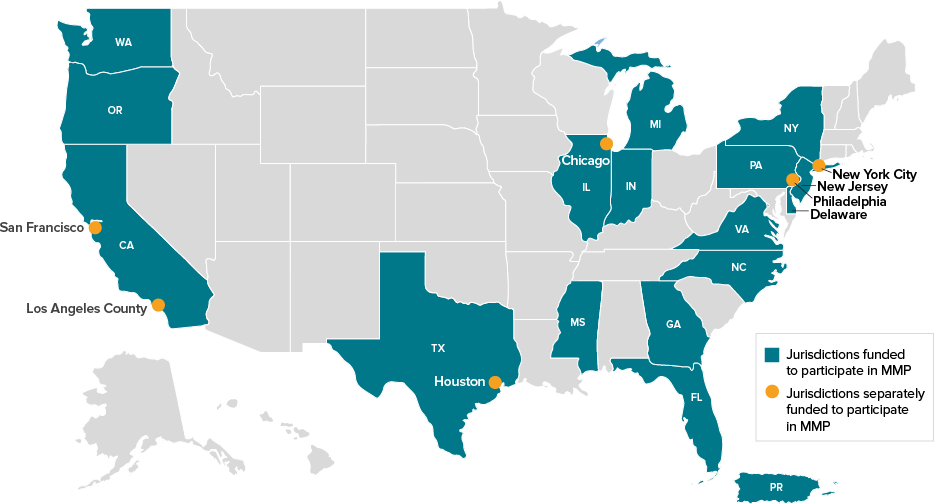
Demographic Characteristics and Social Determinants of Health
An estimated 75% of persons were cisgender male, 23% were cisgender female, and 2% were transgender (Figure 2; Table 2). Nearly three-quarters (74%) were aged at least 40 years. An estimated 43% identified as lesbian or gay; 43% as heterosexual or straight; 10% as bisexual; and 4% as another sexual orientation. An estimated 41% identified as Black or African American, 24% identified as Hispanic or Latino, 28% identified as White, 5% identified as multiracial, 1% identified as Asian, and <1% identified as American Indian or Alaska Native persons.
Figure 2a. Distribution of Gender Among Adults with Diagnosed HIV—Medical Monitoring Project, United States, 2021
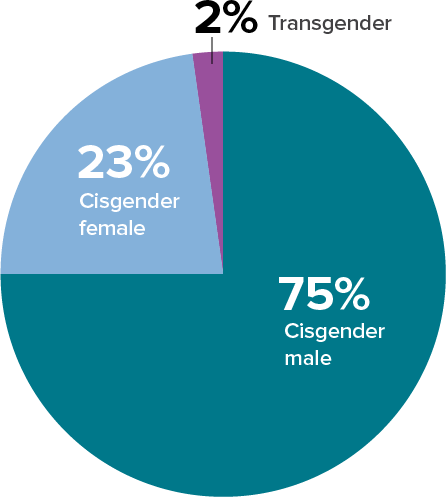
Note. Transgender persons defined as those who self-identified as transgender or who reported a gender identity different from sex assigned at birth.
Figure 2b. Distribution of Age Among Adults with Diagnosed HIV—Medical Monitoring Project, United States, 2021
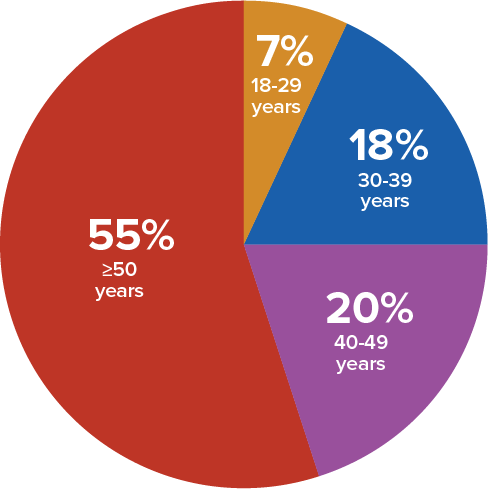
Figure 2c. Distribution of Sexual Orientation Among Adults with Diagnosed HIV—Medical Monitoring Project, United States, 2021
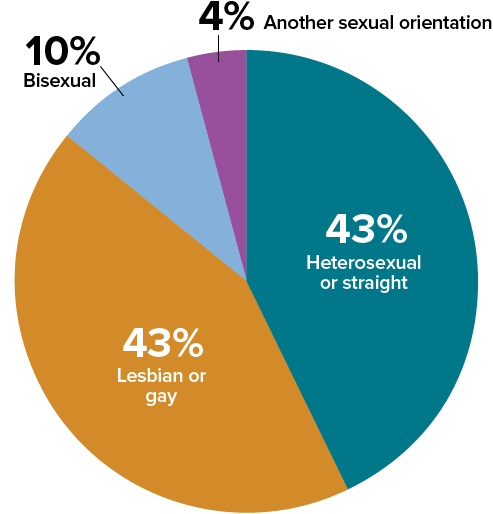
Figure 2d. Distribution of Race/Ethnicity Among Adults with Diagnosed HIV—Medical Monitoring Project, United States, 2021
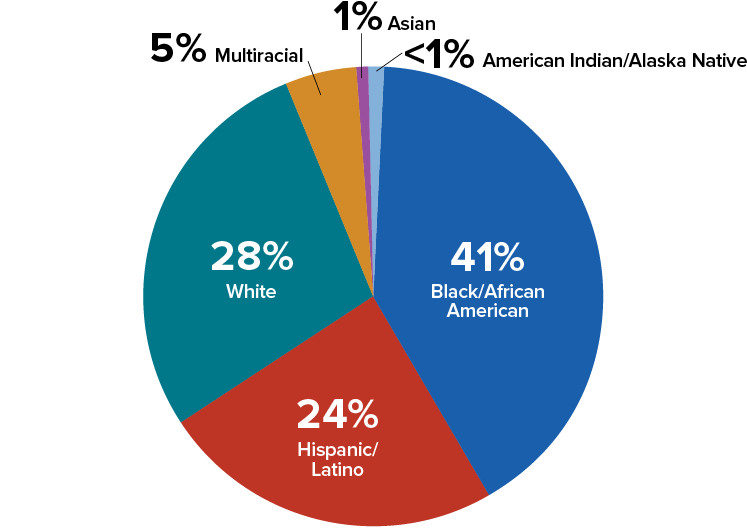
Note. Data for Native Hawaiian and other Pacific Islander persons are not included because the estimate is unstable and therefore suppressed. Hispanic/Latino persons could identify as any race and are grouped separately.
The estimated prevalence of unstable housing or homelessness among all persons with diagnosed HIV was 17%; 15% experienced unstable housing, and 8% experienced homelessness at any time during the past 12 months (Table 2). Approximately 16% experienced hunger or food insecurity, 39% were unemployed or unable to work, and 38% had household incomes below the federal poverty threshold. An estimated 16% received Supplemental Security Income (SSI), and 19% received Social Security Disability Insurance (SSDI). An estimated 41% had a high school education or less. An estimated 99% had health insurance or coverage for care or medications (including antiretroviral therapy [ART] medications): 47% had coverage through the Ryan White HIV/AIDS Program (RWHAP), 43% had Medicaid, 42% had private health insurance, and 29% had Medicare (Figure 3). An estimated 9% were uninsured, including those who received RWHAP assistance only. Overall, 69% perceived their general health as good, very good, or excellent. An estimated 41% had a disability. An estimated 17% were born outside the United States and its territories.
Figure 3a. Prevalence of Socioeconomic Factors and Incarceration Among Adults with Diagnosed HIV—Medical Monitoring Project, United States, 2021
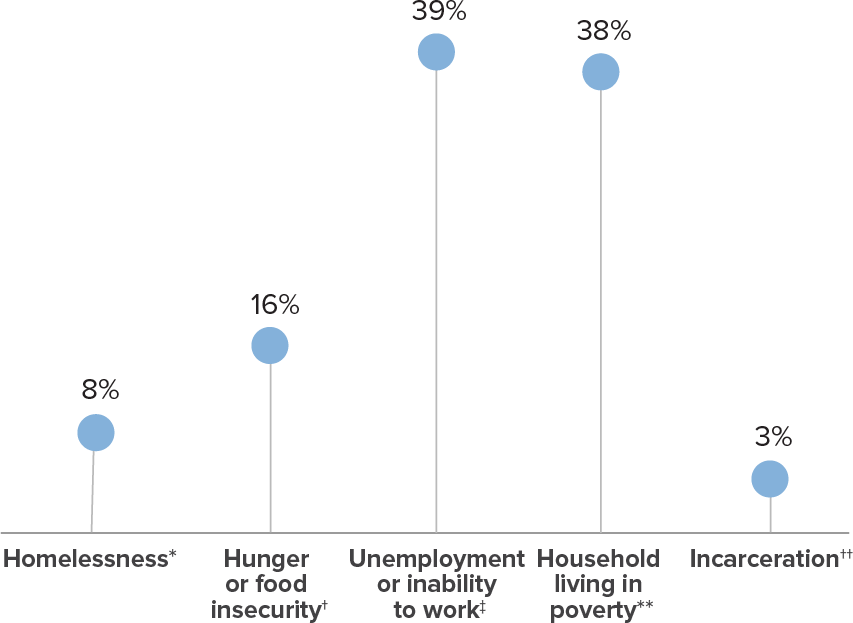
* Homelessness is defined as living on the street, in a shelter, in a single-room-occupancy hotel, or in a car at any time during the past 12 months.
† Hunger or food insecurity is defined as going without food due to lack of money during the past 12 months.
‡ Unemployment or inability to work includes those who were unemployed or unable to work at the time of the interview; employed included employed for wages, self-employed, or homemaker.
** Household poverty level is based on HHS poverty guidelines. The 2020 guidelines were used for persons interviewed in 2021 and the 2021 guidelines were used for persons interviewed in 2022. More information regarding HHS poverty guidelines can be found at: https://aspe.hhs.gov/frequently-asked-questions-related-poverty-guidelines-and-poverty.
†† Incarcerated >24 hours at any point during the past 12 months.
Figure 3b. Prevalence of SSI and SSDI Benefits Among Adults with Diagnosed HIV—Medical Monitoring Project, United States, 2021
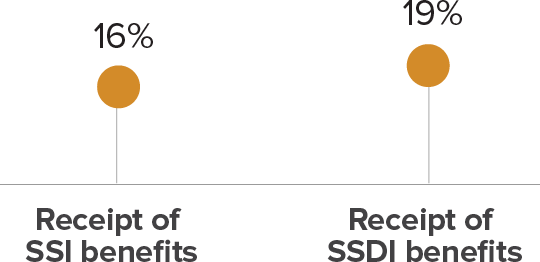
Abbreviations. SSI=Supplemental Security Income; SSDI=Social Security Disability Insurance.
Figure 3c. Prevalence of Health Insurance of Coverage for Care or Medications Among Adults with Diagnosed HIV—Medical Monitoring Project, United States, 2021
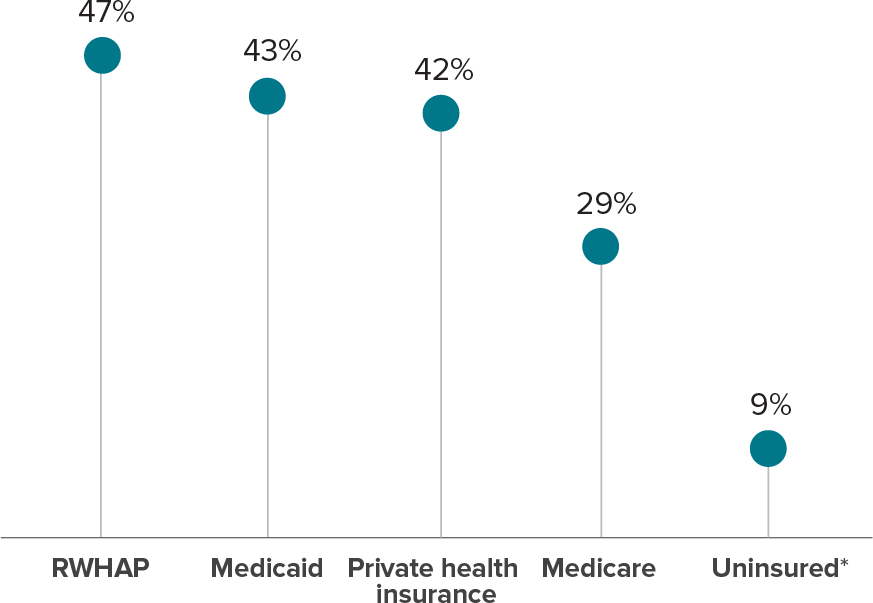
Abbreviations. RWHAP=Ryan White HIV/AIDS Program.
Note. Health care insurance/coverage types not mutually exclusive; people could report >1 type of coverage.
* Includes people who only have health care through the Ryan White HIV/AIDS Program.
Clinical Characteristics
Overall, 69% received an HIV diagnosis at least 10 years earlier (Table 3). According to the CDC stage of disease classification for HIV infection [11], an estimated 53% of persons ever had stage 3 (AIDS) disease. An estimated 7% of persons had a geometric mean CD4 T-lymphocyte (CD4) count of 0–199 cells/µL. The estimated average geometric mean CD4 count among all persons was 659.5 cells/µL, and the median geometric mean CD4 count was 627.1 cells/µL (range, 0–2,572) (data not shown in table).
An estimated 66% of persons had a viral load that was undetectable or < 200 copies/mL at the most recent measurement, while 62% had viral loads that were undetectable or < 200 copies/mL at all measurements during the past 12 months (sustained viral suppression) (Figure 4; Table 3).
Figure 4. Percentage of Adults with Diagnosed HIV Who Were Virally Suppressed During the 12 Months Before Interview—Medical Monitoring Project, United States, 2021
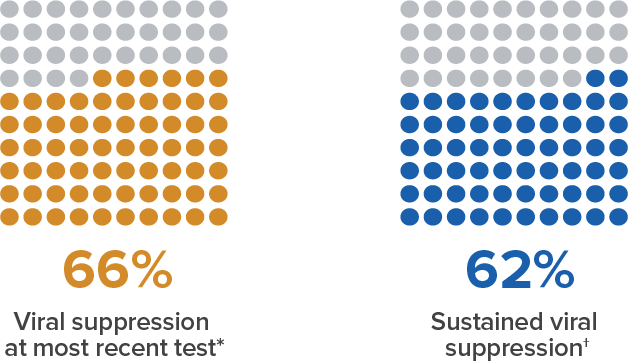
* Viral load <200 copies/mL or undetectable based on most recent test in the past 12 months.
† Sustained viral suppression defined as having all viral load tests in the past 12 months <200 copies/mL or undetectable.
Use of Health Care Services and Antiretroviral Treatment (ART)
Overall, 95% had received outpatient HIV care during the past 12 months (Figure 5; Table 4). An estimated 71% were retained in care during the past 12 months, and 51% were retained in care during the past 24 months. An estimated 80% of persons had an ART prescription documented in the medical record during the 12 months before interview. Of persons who met the clinical criteria for Pneumocystis pneumonia (PCP) prophylaxis, 29% had a prescription for PCP prophylaxis documented in the medical record.
Figure 5. Receipt of HIV Care and Antiretroviral Therapy Prescription During the 12 Months Before Interview Among Adults with Diagnosed HIV—Medical Monitoring Project, United States, 2021
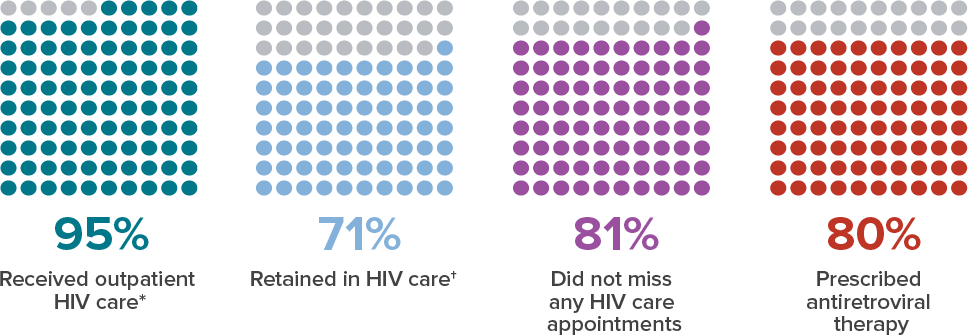
* Outpatient HIV care was defined as any documentation of the following: encounter with an HIV care provider, viral load test results, CD4 test result, HIV resistance test or tropism assay, ART prescription, PCP prophylaxis, or MAC prophylaxis.
† Had ≥2 elements of outpatient HIV care at least 90 days apart during the 12 months prior to interview.
Among persons sexually active, an estimated 49% were tested for gonorrhea, 49% for chlamydia, 62% for syphilis, and 42% for all 3 sexually transmitted infections (STIs) (Figure 6; Table 5).
Figure 6. Percentage of Sexually Active Adults with Diagnosed HIV Who Tested for Gonorrhea, Chlamydia, or Syphilis During the 12 Months Before Interview—Medical Monitoring Project, United States, 2021

An estimated 37% of persons were seen in an emergency department at least once during the past 12 months, and 4% were seen at least 5 times (Figure 7; Table 6). An estimated 17% of persons were admitted to a hospital for an illness at least once during the past 12 months.
Figure 7. Percentage of Adults with Diagnosed HIV Who Had At Least One Visit to the Emergency Room Or At Least One Hospital Admission During the 12 Months Before Interview—Medical Monitoring Project, United States, 2021
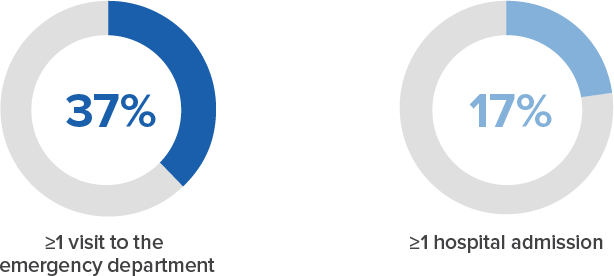
An estimated 98% of persons had ever taken ART, and 95% of persons were currently taking ART based on self-report (Table 7). Among persons with a history of ART use but who were not currently taking ART, 41% were not taking ART due to money or insurance problems, 26% were not taking ART because the person thought ART would make them feel sick or harm them, and 21% were not taking ART because they did not believe they needed ART.
Among persons taking ART, 80% had never been troubled by ART side effects during the past 30 days; 12% had rarely been troubled (Table 8). Among persons taking ART, 63% took all of their ART doses in the past 30 days. Among persons who had ever missed a dose, the most common reasons given for not taking one’s most recently missed ART dose were forgetting (65%), a change in one’s daily routine or being out of town (42%), or falling asleep early or oversleeping (40%) (Figure 8; Table 8).
Figure 8. Reasons for Missing Last Antiretroviral Therapy Dose Among Adults with Diagnosed HIV Who Have Ever Missed a Dose*—Medical Monitoring Project, United States, 2021
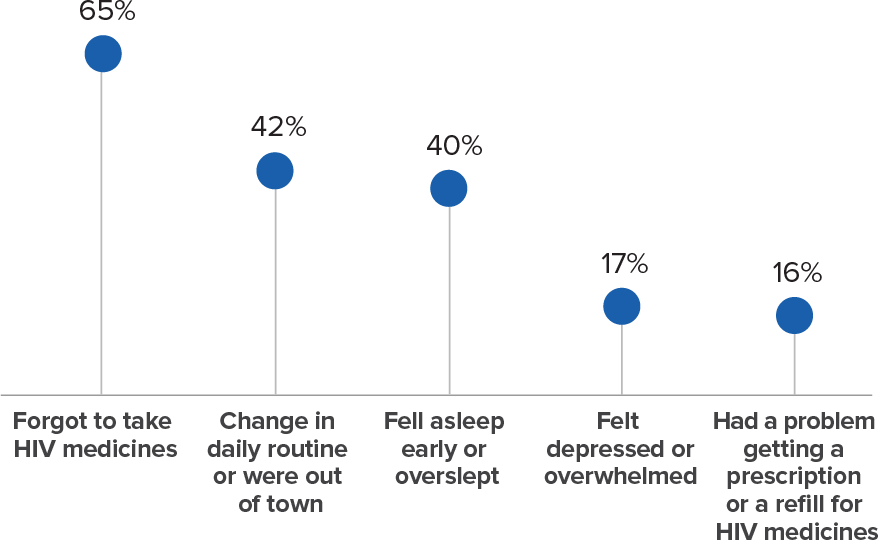
* Participant may report more than one reason for last missed dose.
Clinical Characteristics by Selected Populations
The estimated prevalence of ART prescription documented in a medical record was 80% among cisgender males and 81% among cisgender females (Table 9a). Approximately 79% of bisexual persons and 81% of lesbian or gay persons were prescribed ART, compared with 80% of heterosexual or straight persons. An estimated 79% of Black or African American persons were prescribed ART, compared with 81% of Hispanic or Latino persons and 83% of White persons. The estimated prevalence of ART prescription was 73% among persons aged 18–29 years and 83% among those aged ≥ 50 years. ART prescription was highest during the 2015 cycle at 85% and dropped to 80% during the 2021 cycle (Table 9b).
ART dose adherence in the past 30 days was 63% among cisgender males and 64% among cisgender females. An estimated 56% of bisexual persons and 63% of lesbian or gay persons were ART dose adherent, compared with 66% of heterosexual or straight persons. Approximately 60% of Black or African American persons and 62% of Hispanic or Latino persons were ART adherent, compared with 69% of White persons. An estimated 44% of persons aged 18–29 years were ART adherent, compared with 69% of persons aged ≥ 50 years. ART dose adherence was highest during the 2021 cycle at 63% and was lowest during the 2016 cycle (59%).
The estimated prevalence of sustained viral suppression was 62% among cisgender males and 63% among cisgender females. Approximately 60% of bisexual persons and 63% of lesbian or gay persons, compared with 62% of heterosexual or straight persons, had sustained viral suppression. An estimated 59% of Black or African American persons had sustained viral suppression, compared with 66% of Hispanic or Latino persons and 65% of White persons. The estimated prevalence of sustained viral suppression was 50% among persons aged 18–29 years and 66% among those aged ≥ 50 years. The percentage of persons with sustained viral suppression remained stable between 2015 and 2021.
Mental Health and Substance Use
The estimated prevalence of symptoms indicative of major or other depression during the 2 weeks before interview based on the Patient Health Questionnaire (PHQ-8) algorithm [12] was 15%, including 9% with major depression (Figure 9; Table 10). Based on the total PHQ-8 symptom score (see the appendix), an estimated 13% of persons had symptoms of moderate or severe depression. The estimated prevalence of mild, moderate, or severe symptoms of generalized anxiety disorder during the 2 weeks before interview based on the Generalized Anxiety Disorder Scale (GAD-7) [13] was 21%, including 8% with severe anxiety.
Figure 9a. Percentage of Adults with Diagnosed HIV Who Experienced Symptoms of Major or Other Depression* During the Two Weeks Before Interview—Medical Monitoring Project, United States, 2021
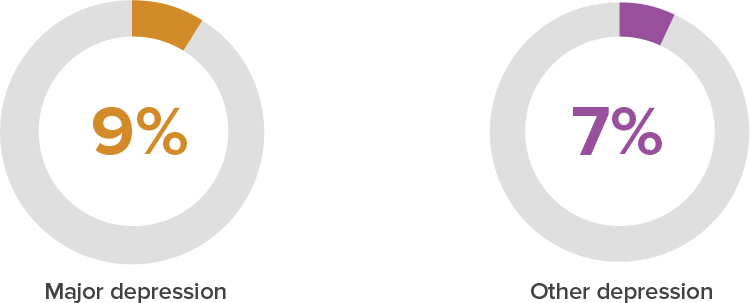
* Responses to the items on the PHQ-8 were used to define “major depression” and “other depression” according to criteria from the DSM-IV. “Major depression” was defined as having at least 5 symptoms of depression; “other depression” was defined as having 2–4 symptoms of depression. The PHQ-8 classification “other depression” comprises the DSM-IV categories of dysthymia and depressive disorder, not otherwise specified, which includes minor or subthreshold depression.
Figure 9b. Percentage of Adults with Diagnosed HIV Who Experienced Symptoms of Generalized Anxiety Disorder* During the Two Weeks Before Interview—Medical Monitoring Project, United States, 2021

* Responses to the GAD-7 were used to define “mild anxiety,” “moderate anxiety,” and “severe anxiety,” according to criteria from the DSM-IV. “Severe anxiety” was defined as having a score of ≥15; “moderate anxiety” was defined as having a score of 10–14; and “mild anxiety” was defined as having a score of 5–9.
The estimated prevalence of current smoking was 29%: 23% of persons smoked daily, 3% weekly, 1% monthly, and 2% less than monthly (Figure 10; Table 11). Overall, 16% of people used electronic cigarettes or other vaping devices in the past 30 days before interview. The estimated prevalence of alcohol use in the past 12 months was 65%: 8% of persons drank alcohol daily, 21% weekly, 11% monthly, and 25% less than monthly (Figure 10; Table 12). An estimated 16% of persons engaged in binge drinking during the past 30 days.
Figure 10a. Percentage of Adults with Diagnosed HIV Who Smoked Cigarettes During the 12 Months Before Interview—Medical Monitoring Project, United States, 2021
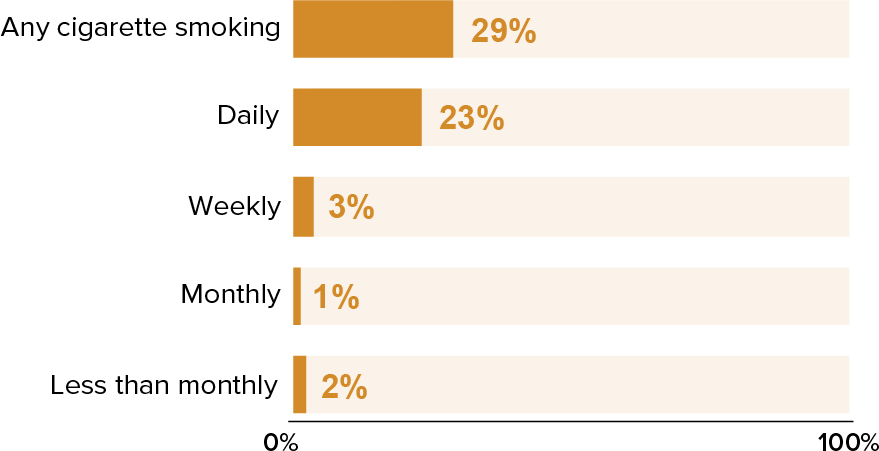
Figure 10b. Percentage of Adults with Diagnosed HIV Who Drank Alcohol During the 12 Months Before Interview—Medical Monitoring Project, United States, 2021
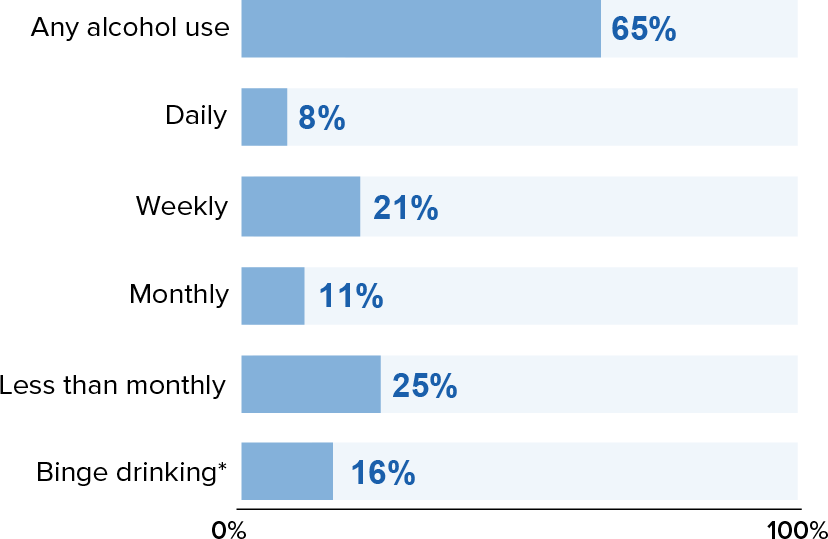
* Persons who drank ≥ 5 alcoholic beverages in a single sitting (≥ 4 for women) during the 30 days before interview.
Figure 10c. Percentage of Adults with Diagnosed HIV Who Used Drugs for Nonmedical Purposes During the 12 Months Before Interview—Medical Monitoring Project, United States, 2021

* Includes all drugs that were not injected (i.e., administered by any route other than injection), including legal drugs that were not used for medical purposes, and vaping marijuana.
Overall, 48% of persons used noninjection or injection drugs for nonmedical purposes in the past 12 months (Figure 10). An estimated 48% of persons used noninjection drugs for nonmedical purposes, including vaping marijuana (Table 13). In total, an estimated 39% used marijuana, 14% used poppers (amyl nitrite), 7% used methamphetamines, 6% used cocaine, 5% used club drugs, 4% used crack, 3% used prescription opioids, 2% used prescription tranquilizers, and 1% used heroin or opium. An estimated 3% of persons used injection drugs for nonmedical purposes (Table 14). In total, an estimated 2% injected methamphetamines, 1% injected heroin, and 1% injected cocaine.
Characteristics Related to Gynecologic and Reproductive Health
Among cisgender women, 83% reported receiving a Papanicolaou (Pap) test in the past 3 years (Figure 11; Table 15). An estimated 33% of females reported being pregnant at least once since receiving an HIV diagnosis.
Figure 11. Percentage of Cisgender Female Adults with Diagnosed HIV Who Had a Papanicolaou Test During the Three Years Before Interview Or Became Pregnant Since Receiving an HIV Diagnosis—Medical Monitoring Project, United States, 2021
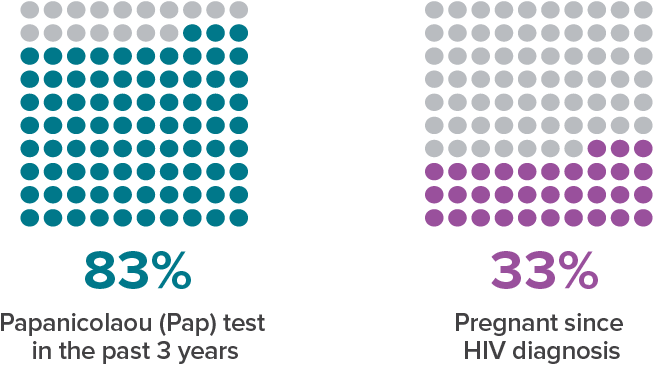
Sexual Behavior
An estimated 61% of cisgender men engaged in vaginal or anal sex; approximately 18% engaged in vaginal sex, 43% had anal sex with cisgender men, and 3% had anal sex with cisgender women (Table 16). Among cisgender women, an estimated 48% engaged in vaginal or anal sex. Approximately 48% had vaginal sex and 5% had anal sex with cisgender men. Among transgender persons, 72% had vaginal or anal sex, and 69% had vaginal or anal sex with cisgender men (Table 17).
Among sexually active cisgender men who had sex with cisgender men (MSM), an estimated 14% engaged in sex without using an HIV prevention strategy, compared with 14% of cisgender men who had sex only with cisgender women (MSW) and 12% of cisgender women who had sex with cisgender men (WSM) (Figure 12; Table 18).
Persons who were sexually active used a variety of HIV prevention strategies. For instance, an estimated 63% of sexually active MSM engaged in sex while having sustained viral suppression, 51% had condom-protected sex, 25% had condomless sex with a partner on preexposure prophylaxis (PrEP), and 53% had sex with a person with HIV (Figure 13; Table 18). Among sexually active MSW, 61% engaged in sex while having sustained viral suppression, 57% had condom-protected sex, and 23% had sex with a person with HIV. Among sexually active WSM, 64% engaged in sex while having sustained viral suppression, 52% had condom-protected sex, and 21% had sex with a person with HIV.
Figure 12. Percentage of Sexually Active Adults with Diagnosed HIV Who Engaged in Sex Without Using an HIV Prevention Strategy* During the 12 Months Before Interview, by Sexual Behavior/Orientation—Medical Monitoring Project, United States, 2021

Abbreviations. MSM=cisgender men who have sex with cisgender men; MSW=cisgender men who have sex only with cisgender women; WSM=cisgender women who have sex with cisgender men.
* Vaginal or anal sex with at least 1 HIV-negative or unknown status partner while not having sustained viral suppression (all viral load measurements in the past 12 months undetectable or <200 copies/mL), when a condom was not used, and the partner was not known to be taking preexposure prophylaxis (PrEP).
Figure 13. Prevention Strategies Used During the 12 Months Before Interview Among Sexually Active Persons with Diagnosed HIV, Including Cisgender Men Who Have Sex with Cisgender Men, Cisgender Men Who Have Sex with Only Cisgender Women, and Cisgender Women Who Have Sex with Cisgender Men—Medical Monitoring Project, United States, 2021
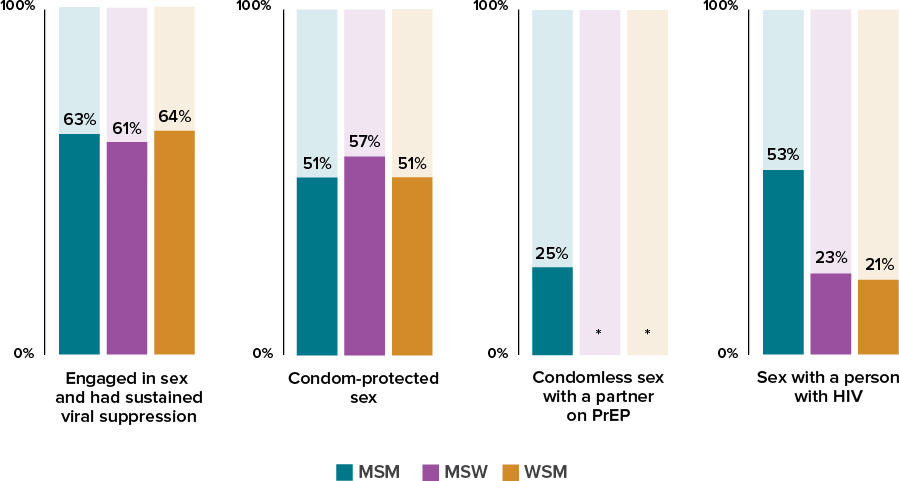
Abbreviations. MSM=cisgender men who have sex with cisgender men; MSW=cisgender men who have sex only with cisgender women; WSM=cisgender women who have sex with cisgender men.
* Estimate is unreliable and therefore suppressed due to having a coefficient of variation ≥0.30 or a denominator sample size <30.
Met and Unmet Need for Ancillary Services
Overall, 93% of people with diagnosed HIV received at least one ancillary service; 71% received at least one HIV support service, 65% received at least one non-HIV medical service, and 50% received at least one subsistence service. Overall, 48% had an unmet need for at least one ancillary service; 19% had an unmet need for at least one HIV support service, 31% had an unmet need for at least one non-HIV medical service, and 23% had an unmet need for at least one subsistence service (not shown in tables or figures).
Among all HIV support services, the most commonly reported service received in the 12 months before interview was HIV case management (50%) (Table 19). Among all persons, estimated unmet need for HIV case management services was 9%; among persons with a need for HIV case management, 15% had an unmet need (Figure 14; Table 19). Of all non-HIV medical care services, the most commonly reported service received was dental care (53%). Among all persons, 25% reported an unmet need for dental care; of all persons with a need for dental care, 32% had an unmet need. Among all subsistence services, the most commonly reported service received was obtained through the Supplemental Nutrition Assistance Program (SNAP) or Special Supplemental Nutrition Program for Women, Infants, and Children (WIC) (38%). Among all persons, 10% had an unmet need for SNAP or WIC services; among persons with a need for SNAP/WIC services, 21% had an unmet need.
Figure 14a. Percentage of Adults with Diagnosed HIV Who Received, or Who Needed But Did Not Receive, Ancillary Services Related to HIV Support During the 12 Months Before Interview—Medical Monitoring Project, United States, 2021
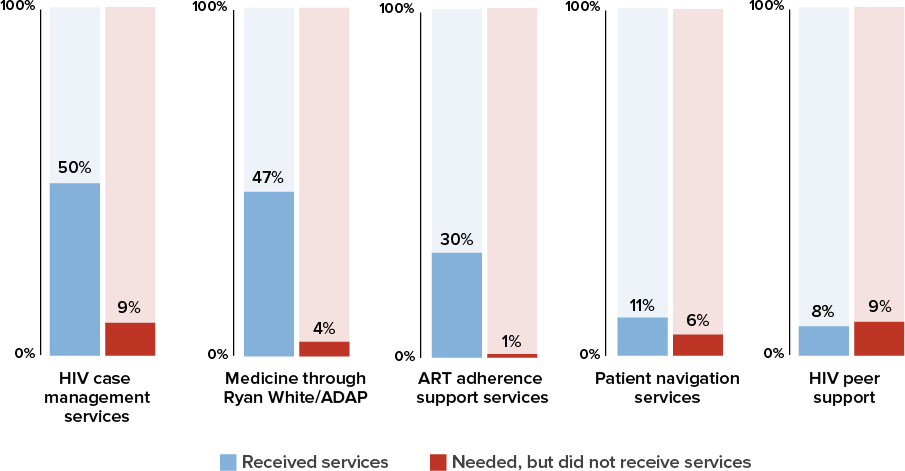
Abbreviations. ADAP=AIDS Drug Assistance Program; ART=Antiretroviral Therapy.
Figure 14b. Percentage of Adults with Diagnosed HIV Who Received, or Who Needed But Did Not Receive, Ancillary Services Related to Non-HIV Medical Services During the 12 Months Before Interview—Medical Monitoring Project, United States, 2021
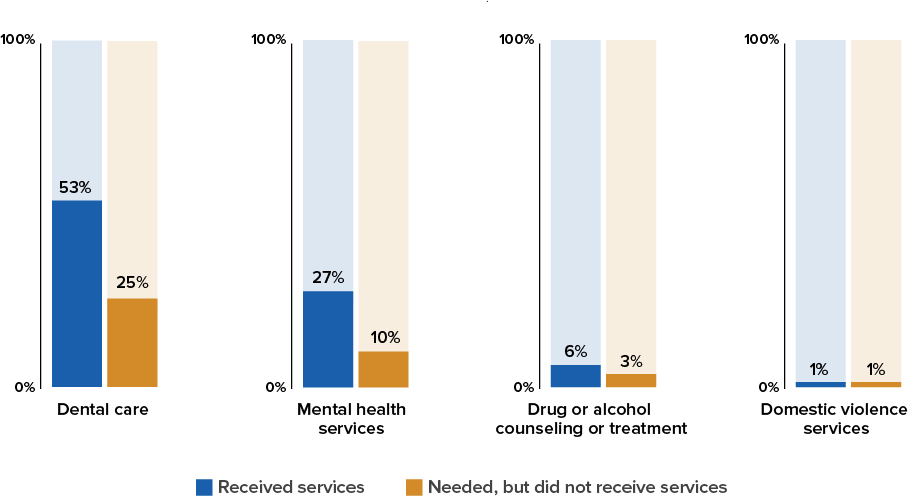
Figure 14c. Percentage of Adults with Diagnosed HIV Who Received, or Who Needed But Did Not Receive, Ancillary Services Related to Subsistence Services During the 12 Months Before Interview—Medical Monitoring Project, United States, 2021
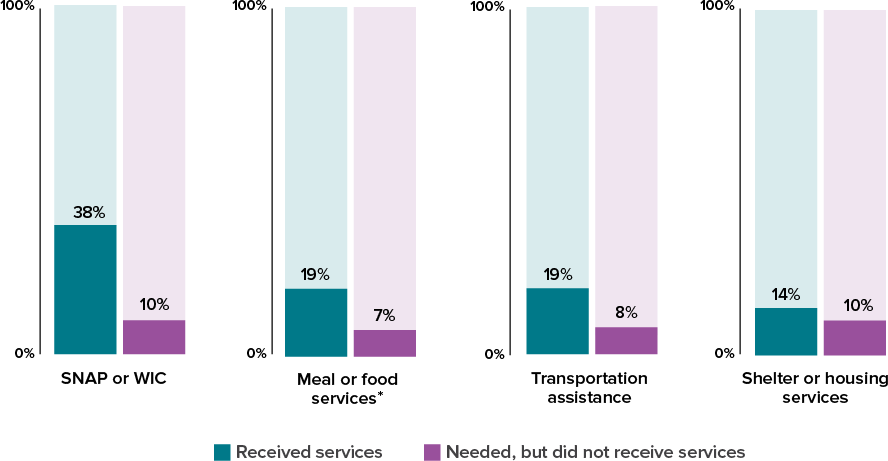
Abbreviations. SNAP=Supplemental Nutrition Assistance Program; WIC=Special Supplemental Nutrition Program for Women, Infants, and Children.
* Includes services such as soup kitchens, food pantries, church dinners, or food delivery services.
Physical Violence and Forced Sex
An estimated 29% of persons had ever been physically hurt by a romantic or sexual partner, including 5% who experienced this in the past 12 months (Figure 15; Table 20). An estimated 17% of persons had ever been threatened with harm or physically forced to have unwanted sex, including 1% who experienced this in the past 12 months.
Figure 15. Percentage of Adults with Diagnosed HIV Who Experienced Physical Violence by an Intimate Partner or Forced Sex During Their Lifetime or the 12 Months Before Interview—Medical Monitoring Project, United States, 2021
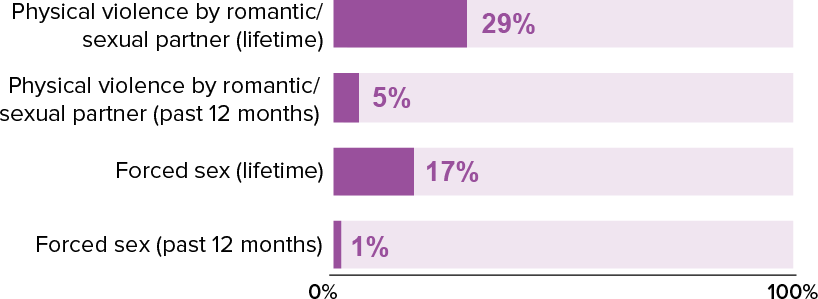
Prevention Activities
An estimated 35% talked with a physician, nurse, or other health care worker about how to prevent HIV or other STDs; 17% talked to an outreach worker, counselor, or prevention program worker about how to prevent HIV or other STDs (Figure 16; Table 21). An estimated 29% of persons received free condoms, excluding those given by a friend, relative, or sex partner.
Figure 16. Receipt of HIV or Sexually Transmitted Disease Prevention Services During the 12 Months Before Interview—Medical Monitoring Project, United States, 2021

National Indicators
Several National HIV/AIDS Strategy (NHAS) indicators are monitored by using MMP data, including 5 quality of life indicators. These include 1 measure of physical health (i.e., self-rated health), 1 measure of mental and emotional health (i.e., unmet needs for mental health services among those who needed services), and 3 structural or subsistence factors (i.e., unstable housing or homelessness, unemployment, and hunger or food insecurity) [7].
During the 2021 cycle, 69% of people reported having good or better self-rated health; the NHAS 2025 target is 95% (Figure 17; Table 22a) [7]. The prevalence of good or better self-rated health was lowest during the 2021 cycle (69%) and highest during the 2018 and 2020 cycles (72%; Table 22b). During the 2021 cycle, 28% of people who had a need for mental health services during the past 12 months did not have their need met; the NHAS 2025 target is 12% (Figure 18; Table 22a) [7]. Unmet need for mental health services was lowest during the 2018 cycle at 20% and highest during the 2021 cycle at 28% (Table 22b). The prevalence of good or better self-rated health and unmet need for mental health services are reported by selected demographic characteristics and NHAS priority populations in Table 22a.
Figure 17. National HIV/AIDS Strategy Indicator: Good or Better Self-Rated Health* Among Adults with Diagnosed HIV, By Cycle Year—Medical Monitoring Project, United States, 2018–2021
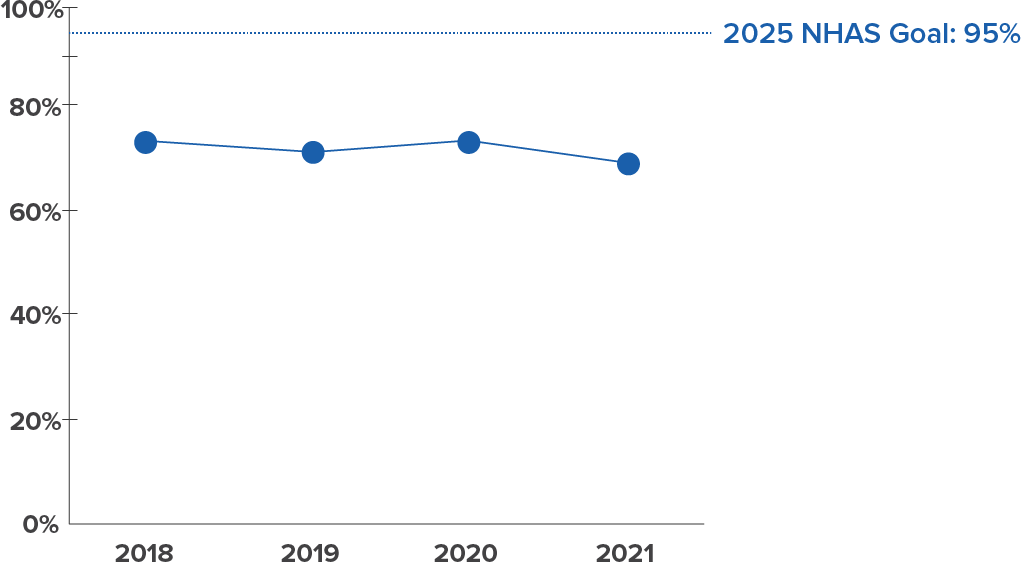
* “Good or better self-rated health” defined as rating one’s health as good, very good, or excellent (as opposed to poor or fair) at the time of interview.
Figure 18. National HIV/AIDS Strategy Indicator: Unmet Needs for Mental Health Services* During the 12 Months Before Interview Among Adults with Diagnosed HIV, By Cycle Year—Medical Monitoring Project, United States, 2015–2021
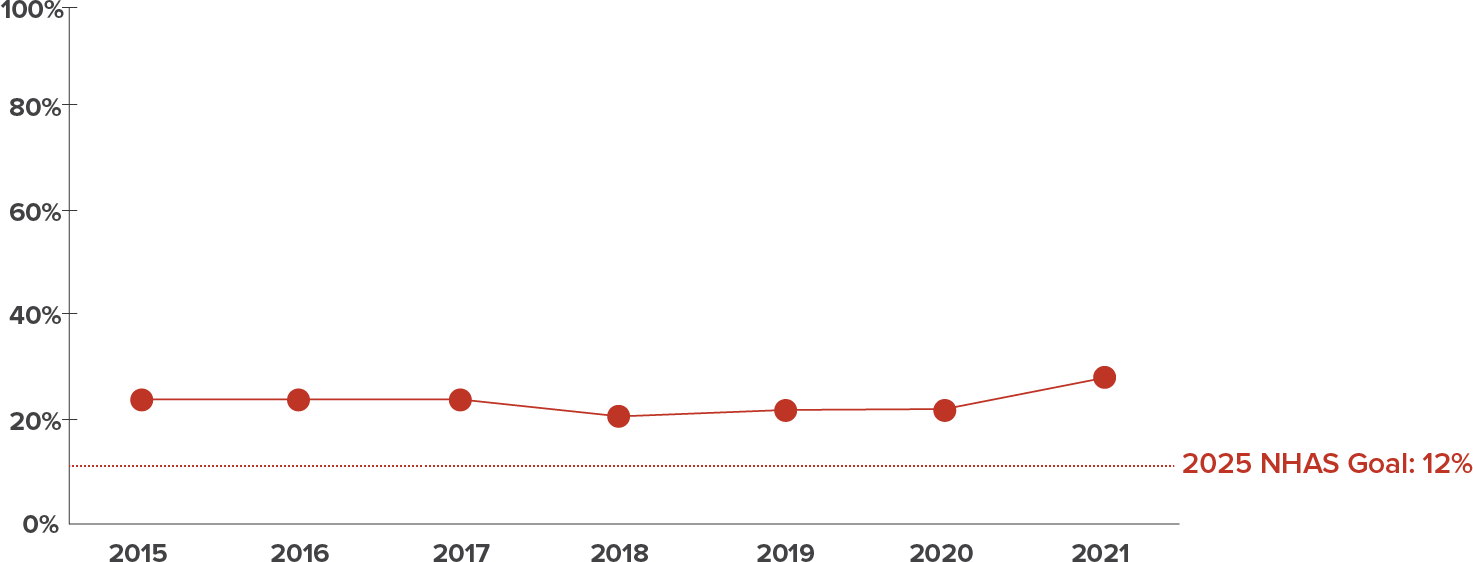
* “Unmet need for mental health services from a mental health professional” defined as needing, but not receiving, services from a mental health professional among those who indicated needing mental health services (i.e., receiving or needing but not receiving) during the past 12 months.
In the 2021 cycle, 17% experienced unstable housing or homelessness during the past 12 months; the NHAS 2025 target is 11% (Figure 19; Table 23a) [7]. During the 2018–2021 cycles, unstable housing or homelessness decreased from 21% to 17% (Table 23b). In the 2021 cycle, 15% reported being unemployed at the time of interview; the 2025 NHAS target is 8% (Figure 20; Table 23a) [7]. During the 2015–2021 cycles, unemployment was lowest during the 2019 cycle (14%) and highest during the 2020 cycle (18%; Table 23b). In the 2021 cycle, 16% of people experienced hunger or food insecurity during the past 12 months; the 2025 NHAS target is 11% (Figure 21; Table 23a) [7]. The prevalence of hunger or food insecurity was lowest during the 2021 cycle (16%) and highest during the 2015 cycle (22%; Table 23b). The prevalence of unstable housing or homelessness, unemployment, and hunger or food insecurity are reported by selected demographic characteristics and NHAS priority populations in Table 23a.
Figure 19. National HIV/AIDS Strategy Indicator: Unstable Housing or Homelessness* During the 12 Months Before Interview Among Adults with Diagnosed HIV, By Cycle Year—Medical Monitoring Project, United States, 2018–2021
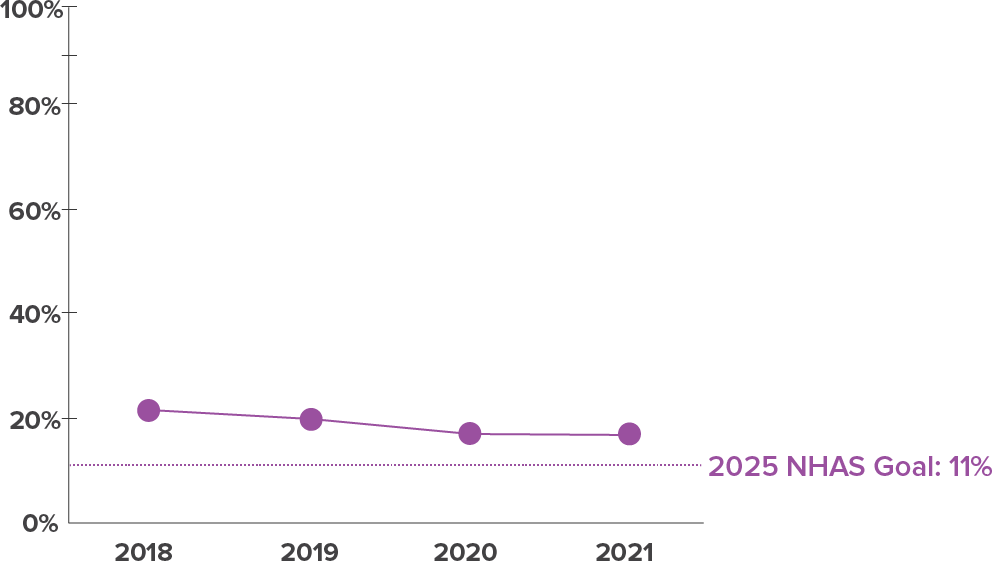
* “Unstable housing or homelessness” defined as experiencing unstable housing (i.e., moving in with others due to financial issues, moving 2 or more times, or being evicted at any time) or homelessness (living on the street, in a shelter, in a single-room–occupancy hotel, or in a car at any time) during the past 12 months.
Figure 20. National HIV/AIDS Strategy Indicator: Unemployment* Among Adults with Diagnosed HIV, By Cycle Year—Medical Monitoring Project, United States, 2015–2021
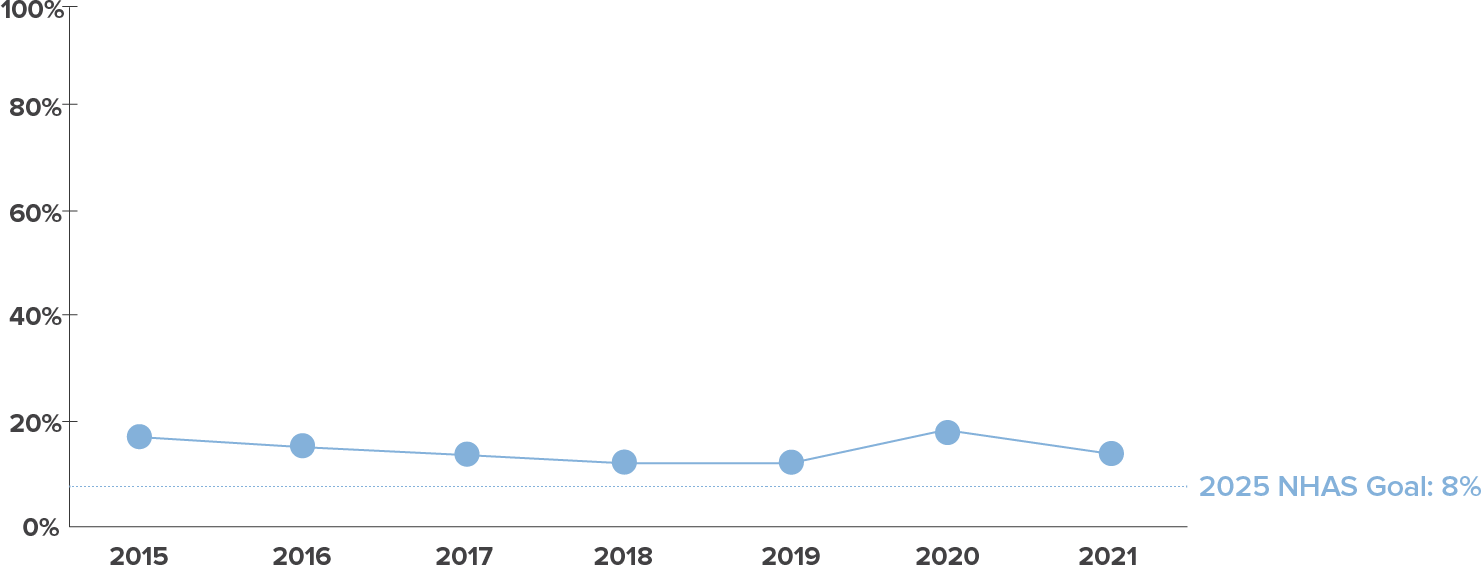
* Unemployed persons included those who reported being unemployed at the time of the interview.
Figure 21. National HIV/AIDS Strategy Indicator: Hunger/Food Insecurity* During the 12 Months Before Interview Among Adults with Diagnosed HIV, By Cycle Year—Medical Monitoring Project, United States, 2015–2021
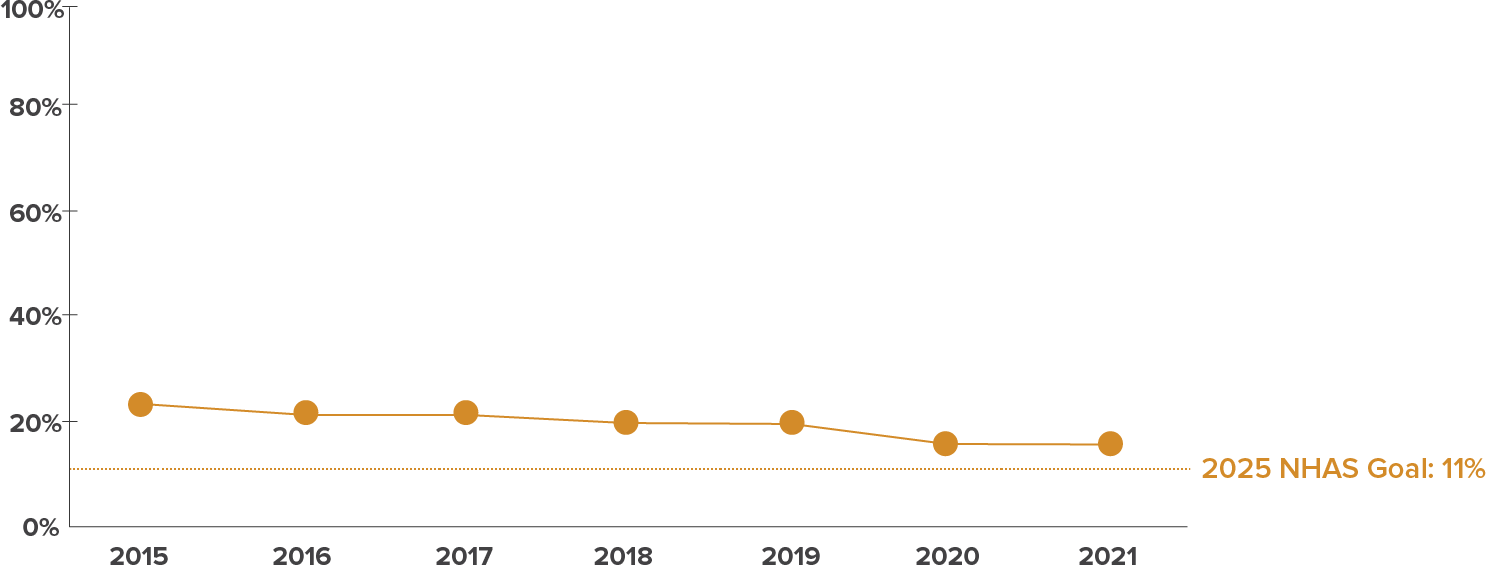
* “Hunger/food insecurity” defined as going without food due to lack of money during the past 12 months.
During the 2021 cycle, the median HIV stigma score was 28.8; the 2025 NHAS target is 16 (Figure 22; Table 24b) [7]. Median HIV stigma scores are reported by selected demographic characteristics and NHAS priority populations in Table 24a. Median HIV stigma score was highest during the 2018 cycle (31.2) and lowest during the 2020 cycle (28.4; Table 24b).
Figure 22. National HIV/AIDS Strategy Indicator: Median HIV Stigma Scores* During the 12 Months Before Interview Among Adults with Diagnosed HIV, By Cycle Year—Medical Monitoring Project, United States, 2018–2021
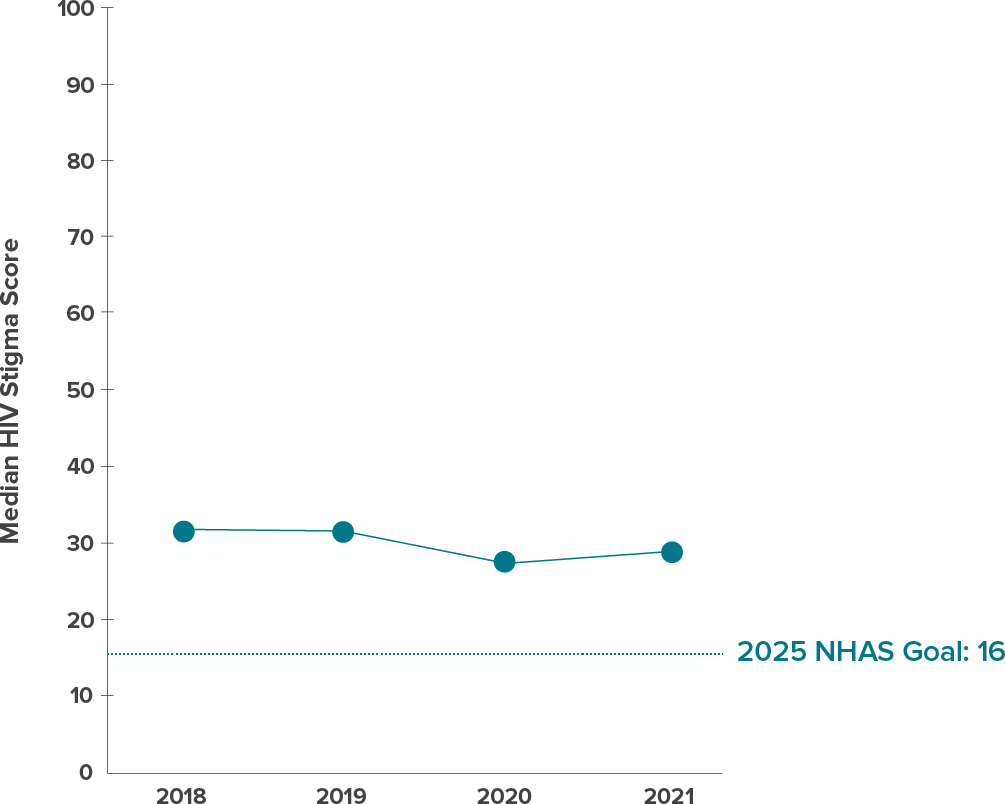
*“Median HIV stigma score” defined as the weighted median score on a 10-item scale ranging from 0 (no stigma) to 100 (high stigma) that measures 4 dimensions of HIV stigma: personalized stigma during the past 12 months, current disclosure concerns, current negative self-image, and current perceived public attitudes about people living with HIV, measured among persons aged ≥18 years with diagnosed HIV infection living in the United States and Puerto Rico.
References
- CDC. HIV Surveillance Report, 2020; vol. 33. https://www.cdc.gov/hiv/library/reports/hiv-surveillance.html. Published May 2022. Accessed July 21, 2023.
- CDC. Medical Monitoring Project (MMP). https://www.cdc.gov/hiv/statistics/systems/mmp/. Accessed July 21, 2023.
- CDC. National HIV Behavioral Surveillance (NHBS). https://www.cdc.gov/hiv/statistics/systems/nhbs/. Accessed July 21, 2023.
- Institute of Medicine. Measuring What Matters: Allocation, Planning and Quality Assessment for the Ryan White CARE Act. Washington, DC: National Academies Press; 2004. https://www.nap.edu/read/10855. Published November 7, 2003. Accessed July 21, 2023.
- CDC. Behavioral and Clinical Characteristics of Persons Receiving Medical Care for HIV Infection—Medical Monitoring Project, United States, 2010. HIV Surveillance Special Report 9. https://www.cdc.gov/hiv/library/reports/hiv-surveillance.html. Published October 2014. Accessed July 21, 2023.
- Institute of Medicine. Monitoring HIV Care in the United States: Indicators and Data Systems. Washington, DC: National Academies Press; 2012. http://dx.doi.org/doi:10.17226/13225 doi:10.17226/13225
- The White House. National HIV/AIDS Strategy for the United States 2022–2025. Washington, DC. https://www.hiv.gov/federal-response/national-hiv-aids-strategy/national-hiv-aids-strategy-2022-2025/. Published December 2021. Accessed July 21, 2023.
- Fauci AS, Redfield RR, Sigounas G, Weahkee MD, Giroir BP. Ending the HIV epidemic: a plan for the United States [editorial]. JAMA 2019;321(9):844–845. http://dx.doi.org/10.1001/jama.2019.1343
- Beer L, Johnson CH, Fagan JL, et al. A national behavioral and clinical surveillance system of adults with diagnosed HIV (the Medical Monitoring Project): Protocol for an annual cross-sectional interview and medical record abstraction survey. JMIR Res Protoc 2019; 8(11):e15453. http://dx.doi.org/10.2196/15453
- SAS Institute Inc. SAS version 9.4. Cary, NC: SAS Institute; 2011.
- CDC [Selik RM, Mokotoff ED, Branson B, Owen SM, Whitmore S, Hall HI]. Revised surveillance case definition for HIV infection—United States, 2014. MMWR 2014;63(RR-03):1–10. https://www.cdc.gov/mmwr/indrr_2014.html. Accessed July 21, 2023.
- Kroenke K, Strine TW, Spitzer RL, et al. The PHQ-8 as a measure of current depression in the general population. J Affect Disord 2009;114(1–3):163–173. http://dx.doi.org/10.1016/j.jad.2008.06.026
- Spitzer RL, Kroenke K, Williams JB, Löwe B. A brief measure for assessing generalized anxiety disorder: the GAD‑7. Arch Intern Med 2006;166(10):1092–1097. https://dx.doi.org/10.1001/archinte.166.10.1092